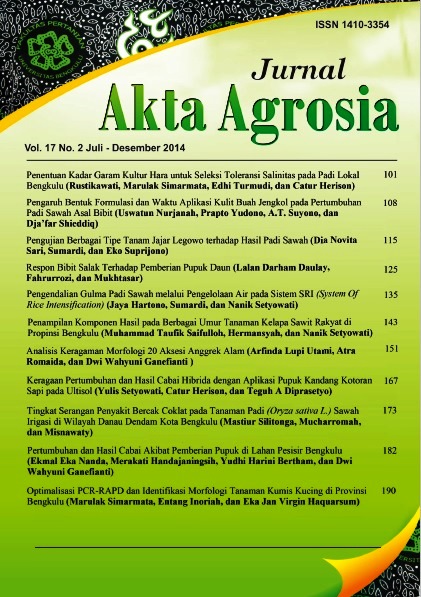Main Article Content
Abstract
Planting wetland paddy by setting row space could be a method to increase rice production. Legowo system is row planting method where we are able to apply different row types on paddy field. The objective of
this research was to identify the best row planting type of ‘Jajar Legowo’ on growth and yield of wetland paddy. Six row plantings, including 2:1 type (means 2 rows are splited by wide space/ legowo), 3:1 type, 4:1 type, 5:1
type, 6:1 type, and 7:1 typ, were tested in a Randomized Complete Block Design with 3 replications Results of the experiment revealed that the highest growth and yield as showed by total number of tillers (28), number of
productive tillers (25), dry-mill rice (66.16 g per plant), and yield difference of dry-mill rice (50.43% per plot) was found at row planting type 2:1. Therefore, row planting type 2:1 can be selected as the best row.
this research was to identify the best row planting type of ‘Jajar Legowo’ on growth and yield of wetland paddy. Six row plantings, including 2:1 type (means 2 rows are splited by wide space/ legowo), 3:1 type, 4:1 type, 5:1
type, 6:1 type, and 7:1 typ, were tested in a Randomized Complete Block Design with 3 replications Results of the experiment revealed that the highest growth and yield as showed by total number of tillers (28), number of
productive tillers (25), dry-mill rice (66.16 g per plant), and yield difference of dry-mill rice (50.43% per plot) was found at row planting type 2:1. Therefore, row planting type 2:1 can be selected as the best row.
Article Details
License
Copyright (c) 2014 Dia Novita Sari, Sumardi Sumardi, Eko Suprijono

This work is licensed under a Creative Commons Attribution-ShareAlike 4.0 International License.
Authors who publish with this journal agree to the following terms:
- Authors retain copyright and grant the journal right of first publication with the work simultaneously licensed under a Creative Commons Attribution License that allows others to share the work with an acknowledgement of the work's authorship and initial publication in this journal.
- Authors are able to enter into separate, additional contractual arrangements for the non-exclusive distribution of the journal's published version of the work (e.g., post it to an institutional repository or publish it in a book), with an acknowledgement of its initial publication in this journal.
- Authors are permitted and encouraged to post their work online (e.g. in institutional repositories or on their website) prior to and during the submission process, as it can lead to productive exchanges, as well as earlier and greater citation of published work (See The Effect of Open Access).
How to Cite
Sari, D. N., Sumardi, S., & Suprijono, E. (2014). Pengujian Berbagai Tipe Tanam Jajar Legowo terhadap Hasil Padi Sawah. Akta Agrosia, 17(2), 115–124. Retrieved from https://ejournal.unib.ac.id/Agrosia/article/view/1089
